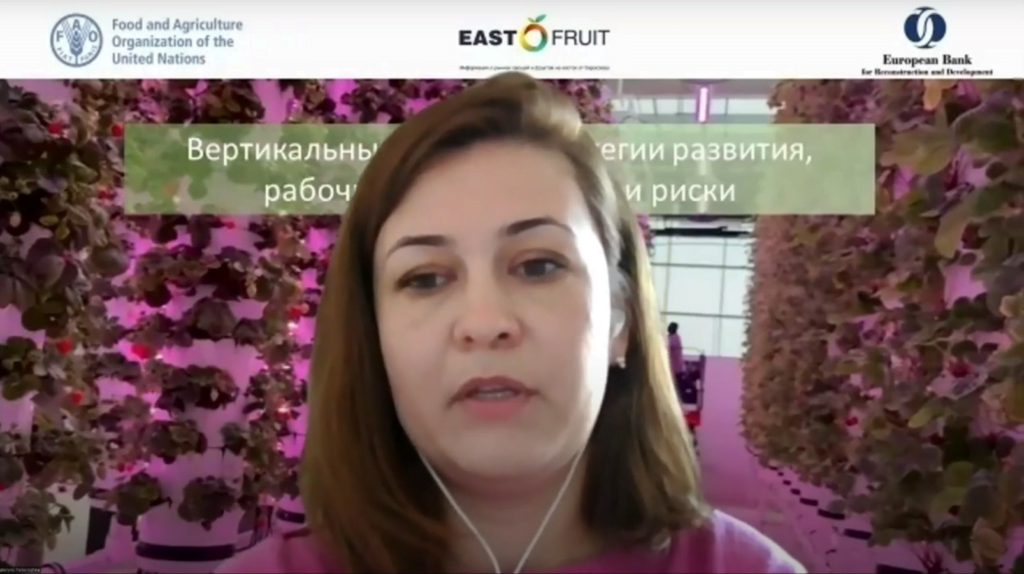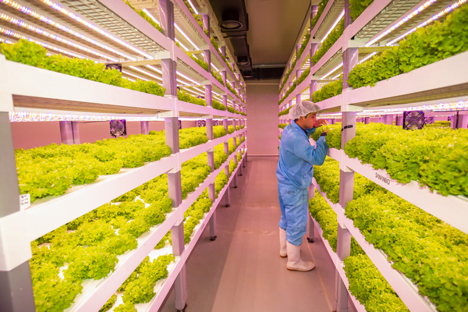Growing horticultural products in vertical farms is sustainable farming and environmentally friendly technologies, but those willing to enter this business should not forget that the costs for it are much higher than in traditional greenhouse farming, and there is still little knowledge, – said the International Consultant of the FAO Investment Center Kateryna Poberezhna at the online conference “Vertical Farms: Development Strategies, Business Models and Risks“.

According to her, when planning the arrangement of a vertical farm, the pros and cons must be weighed. Among the advantages – it is environmentally friendly technologies and sustainable agriculture. Vertical farms help create optimal conditions for growing products, do not depend on seasonality, and maximize the use of space. They help optimize product taste, nutritional value, and yield, reduce water consumption, and for some farms reduce logistical costs and risks. Given global climate change and limited food resources, “green investment” is actively supported by various international organizations. It must be taken into account that one of the main costs is electricity use, and it takes about 7 times more per unit of production than in traditional greenhouses. Challenges are also very expensive technologies and insufficient level of knowledge, especially since this is not only agronomy but also engineering.
As Kateryna Poberezhna noted, there is no exact data on the profitability of vertical farms on a global scale yet. At the same time, there is a lot of advertising for these technologies. And it seems that today the money from this business is earned mainly by equipment manufacturers. Nevertheless, global investments in vertical farms exceeded $3.5 billion in 2021 and are expected to reach $20 billion by 2026.
Kateryna Poberezhna spoke about the global experience in arranging vertical farms, their various types, and technologies for growing plants.
She gave examples of efficient large, fully automated hydroponic and aeroponic farms, hydroponic containers created with the concept of an accelerator and rented out to young people who want to have their business on a part-time basis, container farms that do service farming for retail chains, display-type vertical farms in restaurants and supermarkets, as well as domestic farms of just a few square meters.
Kateryna says the main requirements for the plants that are chosen for growing in vertical farms are short stature, high productivity per square meter, relatively short production cycle, and high nutritional value. But not all of these criteria have been maximized yet. This is especially true for nutritional value.
“Today, vertical farms grow mainly lettuces, herbs, and microgreens. But there is a selection of technologies for growing berries and mushrooms in such farms now – their production cycle is somewhat longer, but the nutritional value is greater,” she added.
As Kateryna Poberezhna noted, the possibility of growing medical and rare plants in a controlled environment is an interesting option. These tend to be labor-intensive crops growing in warm climates and having very little traceability for chemical exposure. A controlled environment allows to increase planting density by several times, accelerate ripening, improve quality, and ensure traceability. Technologies for growing milkweed have already been developed and implemented, the extract of which is used to treat skin diseases. Cultivation under controlled conditions of lettuce chicory, which belongs to the delicacies of French and Belgian cuisine, is practiced. A specialist developed a technology to accelerate its ripening, and increase the dry matter content and is working on a new variety – microchicory. Also, the technology of production in vertical farms of saffron, the most expensive spice in the world, has already been developed. While 6-7 kg of dry saffron is obtained from 1 hectare in the open field, you can get up to 8 kg of dry saffron from 100 square meters of a vertical farm. It is noteworthy that since it does not grow all year round in a vertical farm, it is possible to grow other plants during breaks in the usable area.
The online conference “Vertical Farms: Development Strategies, Business Models and Risks” was organized by the FAO and EBRD project “Climate-Smart Digital Solutions for Fruit and Vegetable Production” with the support of EastFruit and Sapienza Media.
You can see the speech of Kateryna Poberezhna here (in Russian).
The use of the site materials is free if there is a direct and open for search engines hyperlink to a specific publication of the East-Fruit.com website.





1 comment
Again supplemental lights in greenhouses may prove profitable from a certain latitude and northern. At a very North latitude where may be zero light but the country has no CO2 limitation (for example if electricity from Waterfalls) then VF with LEDs is a solution, instead importing from the South – if it is a strategic solution, regardless of costing.
Again if a greenhouse in a very high T place (>80C) then the cooling will cost more than LED light and in that case VF may be viable, if imports are high costing. Again we must let the consumers decide about how much they are willing to pay and of course to be well informed about the quality advantages (not rhetorically but with a proof) and that will be the decisive choices for VFs.